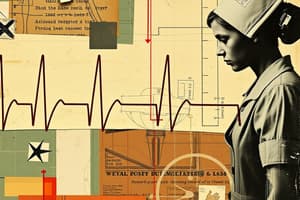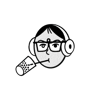Podcast
Questions and Answers
What is the total lung capacity derived from the combination of residual volume, tidal volume, inspiratory reserve volume, and expiratory reserve volume?
What is the total lung capacity derived from the combination of residual volume, tidal volume, inspiratory reserve volume, and expiratory reserve volume?
- 8000 ml
- 7000 ml
- 5000 ml
- 6000 ml (correct)
Which condition is characterized by reduced lung capacity and volumes, typically seen in pulmonary fibrosis?
Which condition is characterized by reduced lung capacity and volumes, typically seen in pulmonary fibrosis?
- Asthma
- Restrictive pulmonary disorder (correct)
- Cystic fibrosis
- Obstructive pulmonary disorder
What factor does NOT influence lung volumes according to body characteristics?
What factor does NOT influence lung volumes according to body characteristics?
- Sex
- Age
- Body size
- Body temperature (correct)
Which pulmonary condition allows for normal or near-normal pulmonary volumes but is characterized by increased airway resistance during breathing?
Which pulmonary condition allows for normal or near-normal pulmonary volumes but is characterized by increased airway resistance during breathing?
Which of the following volumes are combined to calculate inspiratory capacity?
Which of the following volumes are combined to calculate inspiratory capacity?
How does posture affect vital capacity during measurements?
How does posture affect vital capacity during measurements?
What is the primary effect of exercise on lung volumes?
What is the primary effect of exercise on lung volumes?
Which of the following correctly relates to the volume of air inhaled during maximal inspiratory effort following a normal expiration?
Which of the following correctly relates to the volume of air inhaled during maximal inspiratory effort following a normal expiration?
What contributes to tachycardia in an individual?
What contributes to tachycardia in an individual?
Which of the following best describes arterial pulse examination methods?
Which of the following best describes arterial pulse examination methods?
What is the typical pulse rate for a healthy adult male?
What is the typical pulse rate for a healthy adult male?
When does systolic blood pressure occur in relation to the heart's activity?
When does systolic blood pressure occur in relation to the heart's activity?
How should the wrist be positioned when palpating the radial pulse?
How should the wrist be positioned when palpating the radial pulse?
What unit is typically used to record blood pressure?
What unit is typically used to record blood pressure?
Which of the following conditions is most likely to result in bradycardia?
Which of the following conditions is most likely to result in bradycardia?
What determines the variations in blood pressure during each heartbeat?
What determines the variations in blood pressure during each heartbeat?
What does a visual acuity of 20/15 indicate?
What does a visual acuity of 20/15 indicate?
What part of the retina is associated with the blind spot?
What part of the retina is associated with the blind spot?
During the blind spot test, what occurs when the dot focuses on the blind spot?
During the blind spot test, what occurs when the dot focuses on the blind spot?
How does the near point of accommodation change with age, according to the information provided?
How does the near point of accommodation change with age, according to the information provided?
What distance is typically the near point of vision for a 40-year-old individual?
What distance is typically the near point of vision for a 40-year-old individual?
What is not present in the optic disc which contributes to the blind spot?
What is not present in the optic disc which contributes to the blind spot?
What happens to lens elasticity as a person ages?
What happens to lens elasticity as a person ages?
Which of the following correctly describes the testing of visual acuity?
Which of the following correctly describes the testing of visual acuity?
What is the main function of rods and cones in the retina?
What is the main function of rods and cones in the retina?
Which test is typically used for assessing visual acuity?
Which test is typically used for assessing visual acuity?
What does a 20/40 vision ratio indicate?
What does a 20/40 vision ratio indicate?
In which part of the brain is the visual signal processed?
In which part of the brain is the visual signal processed?
What alteration occurs in the photoreceptors when they are exposed to light?
What alteration occurs in the photoreceptors when they are exposed to light?
During the visual acuity test, why should the person wear glasses first and then take the test without them?
During the visual acuity test, why should the person wear glasses first and then take the test without them?
What does visual acuity measure?
What does visual acuity measure?
A person is unable to read letters clearly on the Snellen chart from 20 feet away. What condition might this indicate?
A person is unable to read letters clearly on the Snellen chart from 20 feet away. What condition might this indicate?
What does a positive result in the Rinne Test indicate about a subject's hearing?
What does a positive result in the Rinne Test indicate about a subject's hearing?
In the Weber Test, what outcome suggests the presence of nerve deafness?
In the Weber Test, what outcome suggests the presence of nerve deafness?
How is conductive deafness identified during the Weber Test?
How is conductive deafness identified during the Weber Test?
What is the purpose of the Rinne Test in hearing assessments?
What is the purpose of the Rinne Test in hearing assessments?
During the Rinne Test, if the subject hears the tone again by bone conduction after losing it by air conduction, what does this imply?
During the Rinne Test, if the subject hears the tone again by bone conduction after losing it by air conduction, what does this imply?
What results would indicate equal hearing loss in both ears during the Weber Test?
What results would indicate equal hearing loss in both ears during the Weber Test?
How should the tuning fork be positioned to conduct the Weber Test correctly?
How should the tuning fork be positioned to conduct the Weber Test correctly?
What does the procedure involve when using a tuning fork for the Rinne Test?
What does the procedure involve when using a tuning fork for the Rinne Test?
Flashcards are hidden until you start studying
Study Notes
Pulse Rate Measurement
- Pulse indicates the condition of blood vessel walls and reflects the state of the heart and circulation.
- Pulse is felt in superficial blood vessels, primarily the radial artery, but can also be assessed in the brachial, femoral, posterior tibial, and dorsalis pedis arteries.
- To check the radial pulse, use two or three fingers, avoiding the thumb, with the forearm pronated and wrist slightly flexed.
- Normal pulse rate for a healthy adult is approximately 72 beats per minute.
- Tachycardia is characterized by an increased pulse rate due to factors such as emotion, exercise, fever, or atrial fibrillation.
- Bradycardia describes a decreased pulse rate often linked to heart block.
Arterial Blood Pressure Measurement
- Blood pressure reflects the pressure against blood vessel walls, primarily measured in arteries.
- Blood pressure consists of systolic and diastolic measurements, recorded in millimeters of mercury (mm Hg).
- Systolic pressure measures the peak pressure during ventricular contraction as the heart pumps blood to the body.
Lung Volumes and Capacities
- Four lung volumes combine to total about 6000 ml: Residual volume (1000ml), Tidal volume (500ml), Inspiratory reserve volume (3000ml), Expiratory reserve volume (1500ml).
- Inspiratory capacity reflects the volume of air inhaled after normal tidal expiration and is approximately 3500 ml.
Chronic Pulmonary Diseases
- Two main types:
- Obstructive pulmonary disorders (e.g., emphysema, asthma) involve airflow obstruction and increased airway resistance.
- Restrictive pulmonary disorders (e.g., pulmonary fibrosis) result in reduced lung volumes and capacities.
Factors Influencing Lung Volumes
- Body size, age, sex, exercise, and posture all affect lung capacity measurements.
- Larger individuals generally have greater lung volumes.
- Lung volumes decrease in children and are typically smaller in females.
- Exercise can increase lung volumes, and vital capacity is greater in a sitting position compared to lying down.
Vision Mechanism and Tests
- The eye forms images through light refraction by the cornea and lens, focusing on the retina's rods and cones, which convert light into neural signals.
- Vision tests include checking visual acuity with a Snellen chart, measuring near point accommodation, and assessing for blind spot detection.
- Normal vision is marked as 20/20 on the Snellen chart; values below indicate myopia, and values above indicate better-than-normal vision.
Hearing and Equilibrium Tests
- Hearing assessments utilize tuning forks for the Weber and Rinne tests.
- The Weber test determines conductive versus sensorineural hearing loss by placing the tuning fork on the forehead and checking sound perception in each ear.
- The Rinne test compares bone versus air conduction of sound, evaluating hearing impairment through specific procedures.
Blind Spot Test
- The blind spot test utilizes the optic disc's absence of photoreceptors to observe where an image disappears when focused directly, with measurements recorded for both eyes.
Near Point Accommodation
- Near point distance increases with age, indicating changes in lens elasticity, with specific distances defined for age milestones, from approximately 7 cm at age 10 to 100 cm at age 60.
Studying That Suits You
Use AI to generate personalized quizzes and flashcards to suit your learning preferences.






